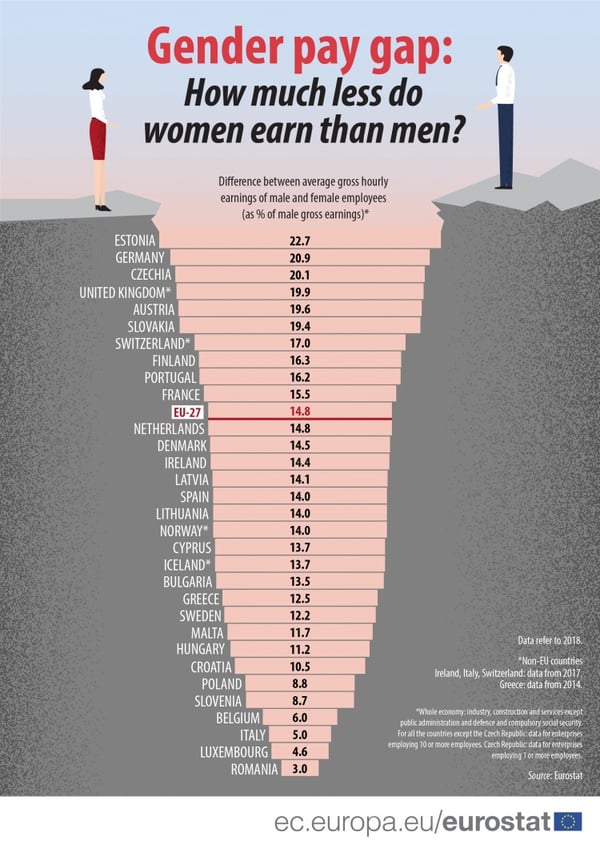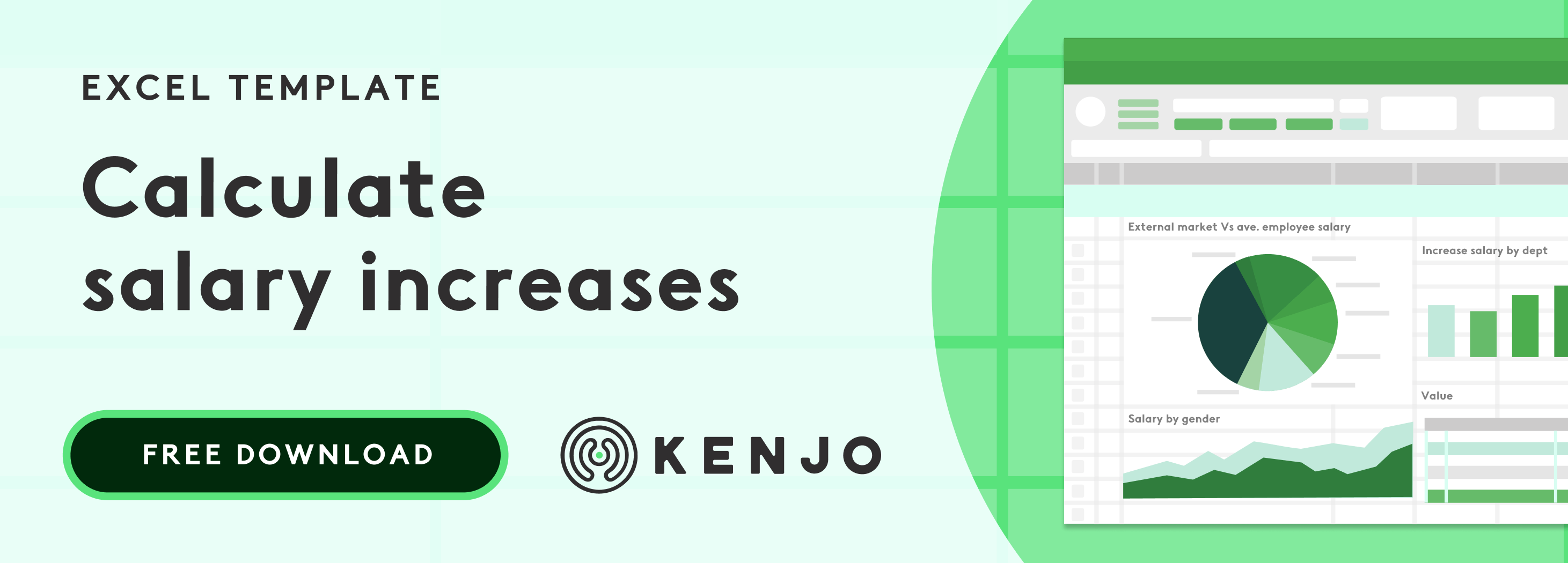What is the gender pay gap?

There is no lack of studies confirming the fact that women earn, on average, less than men. This remuneration difference is known as the gender pay gap. While this gap has been closing in recent years, there is still a long way to go to achieve true gender equality in the working environment.
We dug a little deeper into this by analysing the causes, the situation in the UK and Europe. And we also go over some of the proposals to eliminate the gap.
Definition of gender pay gap
The European Commission defines the gender pay gap as “the difference between the average gross hourly earnings of men and women expressed as a percentage of male earnings.”
The Economic Policy Institute puts it this way: “the gender wage gap is a measure of pay disparity between men and women.”
Unequal pay, on the other hand, is where the value of the work or job role performed by men and women is the same, but the salary is not.
Which European law covers the gender pay gap?
The European Commission published the EU action against pay discrimination in 2014, with the statement: “EU countries must end all discrimination from their national rules and laws.
But the situation in the various European countries differs considerably, as do their laws on the subject. In the UK, for example, the Equality Act 2010 (Gender Pay Gap Information) Regulations 2017 require all private and voluntary sector employers with 250 or more employees to report their gender pay gap.
But according to Reuters, 13 EU member states still have no pay transparency measures in place. Others vary, such as Germany, who introduced the right to pay information for companies with over 200 employees, and Belgium who plan to combat this through collective bargaining.
Main causes of the gender pay gap
The gender pay gap is a complex problem affected by a range of factors which are often interrelated.
Discrimination in the workplace
Women often earn less than men even though they're doing the same job and with the same responsibilities. This usually stems from direct discrimination, where women's work is undervalued.
Companies can mitigate such bias through specific policies or by creating an equality plan.
Barriers to a work-life balance
Women frequently work fewer hours to try and balance their work and family responsibilities. According to an analysis by the European Parliament, only 8.7% of men in Europe work part-time, in comparison to 31.3% of women.
This means that the chances of women advancing within the company or getting a salary increase are drastically reduced. And it's a fact that the gender pay gap increases when women have children and reduce their working hours.
Women have traditionally dedicated more time to looking after their family and work around the house. An article in The Independent revealed that women do the bulk of domestic chores in 93 per cent of the couples analysed in a study by University College London. The study also revealed that women spend approximately 16 hours a week on household chores, while men spend only six.
Salary difference between sectors
Men and women often do different types of work, and so we often find significant polarisation by sector. For example, women are strikingly predominant in the healthcare sector (80% of workers are women). And according to the European Commission report mentioned earlier, there is evidence to suggest that salaries in these sectors are lower than in those which are predominantly male.
Women may have to accept jobs with fewer hours or a lower salary to achieve a work-life balance and few possibilities of promotion to senior posts.
Glass ceiling
The term "glass ceiling" is used to describe an invisible barrier that obstructs women's access to senior positions in business or politics. Only a third of scientists or engineers in Europe are women. And even in the more female-dominated sectors, few positions of responsibility are held by women.
Women now hold a third of boardroom roles in the UK, according to this report in The Guardian.
Women’s work and skills are undervalued
Women's skills and the work they do are often undervalued, which usually results in them enduring poorer conditions. For example, a supermarket cashier is paid less than the man working in the warehouse. Women who do cleaning jobs also earn less than a male street sweeper, and the list goes on.

Is there a gender pay gap in the UK?
What is the gender pay gap in the UK? According to the Office for National Statistics, the gender pay gap among all employees was 15.5% in 2020. This figure has decreased somewhat: it stood at 17.4% in 2019 and a significantly higher 22% in 2010. While the average was 15.5% in 2020, this fluctuates depending on several factors, according to this report published by the UK Parliament. The gender pay gap was much larger for the over 40s, among the 10% top earners and also in South East England.
So despite the government's effort to monitor pay levels in UK businesses, there is still a gender pay gap in the country.
Key gender pay gap statistics in the UK
As we mentioned at the beginning, there is a wide range of reports that confirm the existence of a gender pay gap in the UK, and how the situation currently stands. We've extracted some specific data from these to give you more context.
Gender pay gap by country
According to the European Parliament, women in the European Union earn around 15% less than men. The end of the scale, Estonia has the biggest gender pay gap with 23%, while Romania has the lowest with 3%.
 Image source: Eurostat
Image source: Eurostat
It's worth highlighting that a lower gap doesn't necessarily mean greater gender equality, as this is often seen in countries with lower female employment rates.
Gender pay gap by sector
In terms of discrepancies between sectors, statistics by the BBC and Eurostat reveal that in all member states, except Spain, the gender pay gap was higher in financial and insurance companies. This was as high as 34% in the UK, the fourth-highest rate in Europe.
Interestingly, in a significant number of states, some sectors revealed negative gender pay gaps (where women earn more than men). This was true in the water supply, sewerage and waste management and remediation activities, as well as the construction industry.
Gender pay gap by age
Eurostat also shows that the gender pay gap increases with age due to the career breaks women take in connection with motherhood.
This article published in People Management agrees with this principle and states that the gender pay gap is at its worst when women reach their fifties.
Generally speaking, the younger a woman is, the smaller the gender pay gap will be. And it increases with age, the worst affected being the oldest women with the least qualifications. The reflection point seems to be from 30 years onwards when most women have children. It tends to decrease again slightly at around 40 years of age.
Gender pay gap by region
As we mentioned earlier, the highest gender gaps appear in South East England, with London topping the list. In 2019, women working full-time in London earned 86p for every £1 earned by men. Wales showed the highest level of equality and where women earned 96p for every male £1. Northern Ireland had a negative gender gap, probably because the region has a higher proportion of public sector workers. Public sector workers have a lower gender pay gap than the private sector.
How is the gender pay gap calculated?
The UK Government portal offers step-by-step advice on Making your gender pay gap calculations. We’ve also outlined the main steps you can follow below:
- Define parameters and extract data: decide which metrics you wish to focus on, considering that gender, salary and hours worked are key aspects for analysing the gender pay gap.
- Make the calculations: work out the average hourly pay for men and women and calculate the difference between the two. The formula is: (Men - Women) / x 100 This will give you the gender pay gap in your company.
- Interpret the data: A positive result means that women have lower pay rates than men. A negative result means the opposite. If your answer is zero, then you have gender equality.
If you don't want to do this manually, there are other methods that will help you quickly and easily identify inequalities. For example, let's look at HR analytics tools that offer automatic reports based on data the company already has.
At Kenjo, we have reports and analytics features that show detailed information about employees’ salaries, that you can filter by gender, position in the company, etc. So, you’ll be able to see whether there is a gender pay gap in your company, or not.
How to reduce the gender pay gap
In 2017, the World Economic Forum estimated that it would take 217 years to close the global pay gap. Here are some actions you can take to reduce the gap.
1. Check your gender pay gap regularly
Organisations should set up self-monitoring protocols to identify salary discrepancies between men and women. Data should be segregated by gender, and you could also introduce other relevant variables such as age, time served, training and qualifications, etc.
The government advises companies to develop an equality plan, and those with over 250 employees must submit a gender pay report which analyses this data.
2. Create salary bands for professional categories
Creating salary bands will avoid gender bias that can arise when establishing employee salaries. These bands are set with a minimum and maximum salary for everyone who holds the role in question.
3. Carry our performance reviews
All companies should conduct appraisals on the performance and results achieved for each employee. This will help you when awarding pay increases or promotions and also spot internal talent.
4. Encourage remote working
One thing we’ve learned is that efforts to obtain a work-life balance are among the main causes of the gender pay gap. By facilitating and encouraging remote working in your company, for both fathers and mothers, will enable them to manage childcare more easily without interrupting their career.


